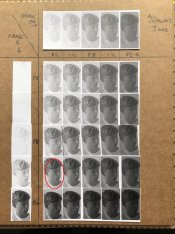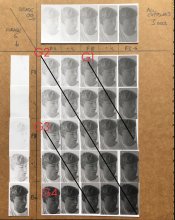I have had a look at your ringed best pic and would tend to agree that while tastes differ it come close to a very small range of pics I think most would choose but what is it that makes you suggest the negative is under-exposed?
IMO underdeveloped, rather than underexposed. Underexposure decreases contrast if it places the mids in the toe of the sensitometric curve, I'd sat this is not the case this time. I can also happen that the paper was bad...
JimEA gave us two versions of a digital picture of his neg. The two do look very different and I have no idea which one represents the correct neg. He has said what he did in each case and expressed his own reservations about how well each represents the "true" neg as each of us would be able to see in person
Well, my reasoning was not based in the picture of the negative, but from the fact that the most acceptale print was done at vey high grade. In theory a negative developed to ISO standard Contrast Index of 0.62 will print well aroun Grade 2, and it looks that in this case grade 4 or 5 is required, suggesting the negative has an abnormal low contrast. Still the pricture of the prints may not have much fidelity...
What I was saying that better to start preliminary testing with a negative that print well in grade 2 or 2.5. Later he may test how to print negatives sporting an "abnormal" contrast.
Is there anything you can suggest that he does when taking the digital pic of the neg that might make it possible to get as close as is possible to the actual neg?
Or course !
The negative can be scanned/photographed alongside with an Stouffer T2115 density wedge, in that case we have an absolute reference. The same with the print, the photograph of the print can be done next to a reflective density wedge. Monitors and prints are not the same, for example the software proofing of a print in a monitor (hybrid case) can be missleading.
It then becomes easier to decide if for the sake of JImEA's future split grade prints what we can suggest he does. I thought he had done well in producing this complete range of split grades for the benefit of others in terms of showing what happens in the range of split grade printing but if our aim is to help him improve on this in terms of the completed print then any practical help we can give is useful. To improve members' ability to do anything associated with film and paper prints has got to be our collective aim, hasn't it ?
Today darkroom printing has a problem: hybrid is quite easy to control. This ends in difficulties to obtain a matching result from optical printing means. Sometimes, what we do in Ps with a few clicks in the curve it can be a nightmare to achieve in the darkroom.
But an authentic well crafted optic print has an inmense value, it sports pure autenticity and the artist's hand is seen in the art, this is a totally different experience both for the photographer and for a trained eye that is able to value that effort.
Still a sound optic print should not show remarkable flaws and it has to be able to show well the creative impulse of the photographer. If one has a doubt, (when possible again) he can see the last exhibition of Sally Mann, it shows the most impressive prints many have seen on a wall, to me that exhibition is like a lighthouse that can be a reference for many, pointing what it can be achieved when a photographer is a master of his tools.
There is nothing easy in the darkroom, this is about testing, testing and testing... and later learning more theory and new techniques just to start a new testing cycle. Not easy, but quite rewarding for some.
IMO, one important thing to remark is that we may start printing before shutter release, the way we craft a negative may be oriented to make easier to obtain the print we want. This is specially true in Large Format because we can make and special development for each individual sheet, but this approach is also usefull for rolls, first we control exposure so for example we can spot meter the shadows to determine its compression, in that way we may save (in part) a difficult burning in the darkroom printing, and the series in a roll may command a similar special development. For example Yousuf Karsh controlled the very well the illumination to nail detail in the shadows, later he developed the negative by inspection (suposedly specially to control highlights). In those times VC paper was not popular, but not many photographers (digital or traditional) deliver that excellence level today...
Just pointing that IMO darkroom printing has limitations (or way more work is required for manipulation), but if we control well film choice, illumination, exposure and development then we can easily deliver impressive results. We may make a more flexible (linear) negative that it may command more effort in the darkroom printing, or we may make a a negative that will print easier like we want. This is a personal choice.




 In particular thanks to....
In particular thanks to....

